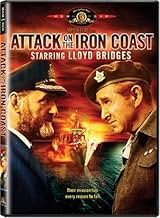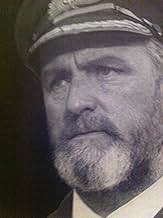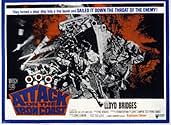IMDb RATING
5.5/10
848
YOUR RATING
During World War II, a commando leader named Major Jamie Wilson leads a group of soldiers on a suicide mission to destroy a Nazi naval stronghold on the French coast.During World War II, a commando leader named Major Jamie Wilson leads a group of soldiers on a suicide mission to destroy a Nazi naval stronghold on the French coast.During World War II, a commando leader named Major Jamie Wilson leads a group of soldiers on a suicide mission to destroy a Nazi naval stronghold on the French coast.
John Abineri
- German Gunnery Sergeant
- (uncredited)
Sean Barrett
- Radio Man
- (uncredited)
Victor Beaumont
- German Battery Commander
- (uncredited)
Peter Brace
- Commando
- (uncredited)
- Director
- Writers
- All cast & crew
- Production, box office & more at IMDbPro
Featured reviews
I'm putting this movie up as one of my favourites. It wasn't glitzy war movie like others common in that time period /ie, Kelly's Heroes/Bridge at Remagen, Dirty Dozen.... It does a great job covering tragedies of war in a wide range of areas - loved ones/ young soldiers/training casualties. Also a great insight from dilemmas faced by operation planners -with limited resources available- right down to fears of rank and file. I always had a keen interest on the Raid of St.Nazaire and Brit commmandos so I was quite pleasantly surprised to stumble upon this movie to see it based on that. Sgt.Slaughter made an error in his review headline- it wasn't Canadian commandos portrayed in the movie -they were British led by a Canadian major -Bridges. The movie's raid action was great. The uniforms / weaponry had a very authentic look too. WW2 Buffs will love this movie -one overlooked unfortunately perhaps due to its lack-lustre box cover design.
I just wanted to point out, that this movie is indeed based on an actual event, the raid on St. Nazaire. The former flush decked WWI Destroyer "Campbeltown" was converted to look like a german "E-Boat" and was loaded with explosives, and rammed into the "Normandie" dry dock. The operation was code named "Operation Chariot", and commenced on March 28th, 1942.
Haunted by his failure in a previous mission, Major Wilson signs up to lead Operation Mad Dog even though the risks are high. Mad Dog seeks to bring several boats of commandos onto a heavily fortified part of France's coast one of them full of explosives. While the commandos raid the shore the ship will explode and reduce the defences to rubble and leave the area open for attack. However accidents during training are only the start of a fraught and dangerous mission.
From this period it is not unusual to have a commando movie if fact they were quite common and quite popular. Taking this as my reason, I decided to watch this film but quickly regretted bothering. The plot is not anything new training a group of men for a risky mission against all the odds. The first half of the film is quite slow and the training is given none of the wit of Dirty Dozen and other movies that have done it better. Worse still is the fact that the film delves into Major Wilson's personal life, giving long scenes the feel of a melodrama. The actual attack is quite short and quite ordinary lots of men running round alleys for 5 minutes. The model work is also pretty poor considering the time it was made they really could have done better.
Another reason for the film lacking teeth is the fact that I never really cared about the characters. It was surprising that, given how much of the film is spent talking, that only the two lead characters were developed to the point that I could give a damn about either of them. Of the two leads, Bridges is miscast and didn't convince me he was a tough wartime Major. Keir however was solid and I enjoyed his character.
Overall this is a pretty poor film that is dull for the most part. It aspires to be a film like Dirty Dozen but it never manages to get anywhere near it. Poor characters, uninvolving development, weak action and a plot that does exactly what you expect it to. Even if you want a film in this genre you can do way better than this.
From this period it is not unusual to have a commando movie if fact they were quite common and quite popular. Taking this as my reason, I decided to watch this film but quickly regretted bothering. The plot is not anything new training a group of men for a risky mission against all the odds. The first half of the film is quite slow and the training is given none of the wit of Dirty Dozen and other movies that have done it better. Worse still is the fact that the film delves into Major Wilson's personal life, giving long scenes the feel of a melodrama. The actual attack is quite short and quite ordinary lots of men running round alleys for 5 minutes. The model work is also pretty poor considering the time it was made they really could have done better.
Another reason for the film lacking teeth is the fact that I never really cared about the characters. It was surprising that, given how much of the film is spent talking, that only the two lead characters were developed to the point that I could give a damn about either of them. Of the two leads, Bridges is miscast and didn't convince me he was a tough wartime Major. Keir however was solid and I enjoyed his character.
Overall this is a pretty poor film that is dull for the most part. It aspires to be a film like Dirty Dozen but it never manages to get anywhere near it. Poor characters, uninvolving development, weak action and a plot that does exactly what you expect it to. Even if you want a film in this genre you can do way better than this.
I saw this movie as a double bill with Yellow Submarine as a treat with some friends for my 9th birthday, Summer 1968 in a cinema in north-eastern England. It was a very odd combination given the likely audience for The Beatles film.
My recollection of the film is very hazy, but the ending made a stronger long-lasting impact on me than the jolly Beatles romp, so I'm giving it a fairly high score. I've wondered ever since what the film was called but have just found a listing of the double-bill in the British Newspaper Archive. Now I'd like to track the film down to see what I think of it as an adult - other reviews are mixed so I hope I'm not too disappointed.
My recollection of the film is very hazy, but the ending made a stronger long-lasting impact on me than the jolly Beatles romp, so I'm giving it a fairly high score. I've wondered ever since what the film was called but have just found a listing of the double-bill in the British Newspaper Archive. Now I'd like to track the film down to see what I think of it as an adult - other reviews are mixed so I hope I'm not too disappointed.
Lloyd Bridges and Andrew Keir play WWII commando leaders who lead a group of soldiers on a suicide mission to destroy a Nazi naval stronghold on the French coast by means of a dead ship turned into a live bomb . As the valiant soldiers sailed it down the throat of the enemy . They carry out their risked assignment while keeping their activities hidden from outsiders and German airplanes . At the end , they arrive in the enemy port commanded by Nazi officers : Van Horst (Walter Gotell) and Captain Strasser (George Mikell) . The Germans had a number of reinforced submarine pens, but the target of the actual attack was the dry dock facilities . It was called ¨The St Nazaire Raid¨ or ¨Operation Chariot¨ that commenced on March 28th, 1942 , it was a successful British amphibious attack on the heavily defended Normandie dry dock at St Nazaire in German-occupied France during the Second World War.
World War II war film loosely based on the Operation Chariot , an attack on the Iron coast in St Nazaire . It's a fictionalized recounting of the known mission on St Nazaire , here called LeClair (Ste-Nazaire) with a sustained and predictable story , although partially based on true deeds . Acceptable acting from Lloyd Bridges and Andrew Keir as two commanders who take on a strong battle of wits . The film progresses with Commander Major Jamie Wilson/Lloyd Bridges -takeoff on Lord Mountbatten- training the crews of the ships , even though the crew lacks faith in his command abilities . He must overcome tensions with his antagonist Captain Franklin/Andrew Keir . This and the 1952 film "Gift Horse" are based on the same World War Two raid carried out by British forces on the locks of the French port of St Nazaire in 1942 . The highlights of the movie are the violent as well as exciting fights of the crews who successfully fend off an final attack at St. Nazaire or LeClair . And thrilling scenes at the final when the ship penetrates the highly armored stronghold , nets in the port , and explosives blow up under the dry dock . It includes stock WWII , especially when show up some planes , the clips of the diversionary air raid were taken from the film The Dam Busters (1955) . Atmospheric cinematography by Paul Beeson , Walt Disney's usual cameraman, though an alright remastering is necessary . Being filmed on location , shooting was filmed in Gaddesden Place, Hemel Hempstead, Hertfordshire,Millwall Dock, Millwall, London, England, UK (French port of St. Nazaire) and St Katharine Docks, London, England, UK . Good and enjoyable musical score by Gerard Schurmann , though parts of Ron Goodwin's score from Squadron 633 (1964) were used without credit.
The film was produced by Oakmont production , a company exclusively dedicated to warfare films (Submarine X1 , Hell boats , Mosquito Squadron , Thousand plane raid , Last escape) . The motion picture was professionally realized by Paul Wendkos who displays enough spectacular images to keep things interesting . Apparently, director worked on the film's original screen story with writer/producer John C. Champion but is uncredited for such . Wendkos whose works remain undervalued in USA directed various TV series and some films as ¨Guns of the Magnificent Seven¨ , ¨Cannon for Cordoba¨, ¨Gidget¨, ¨The Flight¨, ¨The legend of Lizzie Borden¨ and ¨Hell boats¨
The film is based on real facts , these were the followings : The operation was undertaken by the Royal Navy and British Commandos under the auspices of Combined Operations Headquarters on 28 March 1942. The extra ships were along to transport all those who took part back to England after the operation. All of the 18 addition ships were sank during the attack. Other ships did accompany the attack but remained outside the area of the attack. In the actual operation the obsolete destroyer HMS Campbeltown was the lead ship in the attack. She was accompanied by 18 other smaller craft. St Nazaire was targeted because the loss of its dry dock would force any large German warship in need of repairs, such as the Tirpitz, to return to home waters via either the English Channel or the GIUK gap, both of which were heavily defended by British units including the Royal Navy's Home Fleet, rather than having a haven available on the Atlantic coast. The obsolete destroyer HMS Campbeltown, accompanied by 18 smaller craft, crossed the English Channel to the Atlantic coast of France and was rammed into the Normandie dock gates. The ship had been packed with delayed-action explosives, well hidden within a steel and concrete case, that detonated later that day, putting the dock out of service for the remainder of the war and up to five years after. A force of commandos landed to destroy machinery and other structures. Heavy German gunfire sank, set ablaze or immobilised virtually all the small craft intended to transport the commandos back to England ; the commandos had to fight their way out through the town to try to escape overland. Almost all were forced to surrender when their ammunition was expended and they were surrounded . After the raid 228 men of the force of 611 returned to Britain; 169 were killed and 215 became prisoners of war. German casualties were over 360 dead, some killed after the raid when Campbeltown exploded. To recognise their bravery, 89 decorations were awarded to members of the raiding party, including five Victoria Crosses. After the war, St Nazaire was one of 38 battle honours awarded to the Commandos; the operation has since become known as The Greatest Raid of All within military circles. The men who took part in this attack received more awards for bravery then any other operation of it's length then any other operation before or since.
World War II war film loosely based on the Operation Chariot , an attack on the Iron coast in St Nazaire . It's a fictionalized recounting of the known mission on St Nazaire , here called LeClair (Ste-Nazaire) with a sustained and predictable story , although partially based on true deeds . Acceptable acting from Lloyd Bridges and Andrew Keir as two commanders who take on a strong battle of wits . The film progresses with Commander Major Jamie Wilson/Lloyd Bridges -takeoff on Lord Mountbatten- training the crews of the ships , even though the crew lacks faith in his command abilities . He must overcome tensions with his antagonist Captain Franklin/Andrew Keir . This and the 1952 film "Gift Horse" are based on the same World War Two raid carried out by British forces on the locks of the French port of St Nazaire in 1942 . The highlights of the movie are the violent as well as exciting fights of the crews who successfully fend off an final attack at St. Nazaire or LeClair . And thrilling scenes at the final when the ship penetrates the highly armored stronghold , nets in the port , and explosives blow up under the dry dock . It includes stock WWII , especially when show up some planes , the clips of the diversionary air raid were taken from the film The Dam Busters (1955) . Atmospheric cinematography by Paul Beeson , Walt Disney's usual cameraman, though an alright remastering is necessary . Being filmed on location , shooting was filmed in Gaddesden Place, Hemel Hempstead, Hertfordshire,Millwall Dock, Millwall, London, England, UK (French port of St. Nazaire) and St Katharine Docks, London, England, UK . Good and enjoyable musical score by Gerard Schurmann , though parts of Ron Goodwin's score from Squadron 633 (1964) were used without credit.
The film was produced by Oakmont production , a company exclusively dedicated to warfare films (Submarine X1 , Hell boats , Mosquito Squadron , Thousand plane raid , Last escape) . The motion picture was professionally realized by Paul Wendkos who displays enough spectacular images to keep things interesting . Apparently, director worked on the film's original screen story with writer/producer John C. Champion but is uncredited for such . Wendkos whose works remain undervalued in USA directed various TV series and some films as ¨Guns of the Magnificent Seven¨ , ¨Cannon for Cordoba¨, ¨Gidget¨, ¨The Flight¨, ¨The legend of Lizzie Borden¨ and ¨Hell boats¨
The film is based on real facts , these were the followings : The operation was undertaken by the Royal Navy and British Commandos under the auspices of Combined Operations Headquarters on 28 March 1942. The extra ships were along to transport all those who took part back to England after the operation. All of the 18 addition ships were sank during the attack. Other ships did accompany the attack but remained outside the area of the attack. In the actual operation the obsolete destroyer HMS Campbeltown was the lead ship in the attack. She was accompanied by 18 other smaller craft. St Nazaire was targeted because the loss of its dry dock would force any large German warship in need of repairs, such as the Tirpitz, to return to home waters via either the English Channel or the GIUK gap, both of which were heavily defended by British units including the Royal Navy's Home Fleet, rather than having a haven available on the Atlantic coast. The obsolete destroyer HMS Campbeltown, accompanied by 18 smaller craft, crossed the English Channel to the Atlantic coast of France and was rammed into the Normandie dock gates. The ship had been packed with delayed-action explosives, well hidden within a steel and concrete case, that detonated later that day, putting the dock out of service for the remainder of the war and up to five years after. A force of commandos landed to destroy machinery and other structures. Heavy German gunfire sank, set ablaze or immobilised virtually all the small craft intended to transport the commandos back to England ; the commandos had to fight their way out through the town to try to escape overland. Almost all were forced to surrender when their ammunition was expended and they were surrounded . After the raid 228 men of the force of 611 returned to Britain; 169 were killed and 215 became prisoners of war. German casualties were over 360 dead, some killed after the raid when Campbeltown exploded. To recognise their bravery, 89 decorations were awarded to members of the raiding party, including five Victoria Crosses. After the war, St Nazaire was one of 38 battle honours awarded to the Commandos; the operation has since become known as The Greatest Raid of All within military circles. The men who took part in this attack received more awards for bravery then any other operation of it's length then any other operation before or since.
Did you know
- TriviaUnlike the movie where the German Commander seemed to sense that the ship could be a real problem; when the ship blew up several hours later there was a group of about 30 German officers touring the craft when it blew up.
- GoofsIn the opening scene Lloyd Bridges is watching newsreel footage of British troops attacking Germans but some of the shots are from the German point of view.
- ConnectionsEdited from Les briseurs de barrages (1955)
- How long is Attack on the Iron Coast?Powered by Alexa
Details
- Release date
- Countries of origin
- Language
- Also known as
- Attack on the Iron Coast
- Filming locations
- Millwall Dock, Millwall, London, England, UK(French port of St. Nazaire)
- Production companies
- See more company credits at IMDbPro
Box office
- Budget
- $1,000,000 (estimated)
- Runtime1 hour 29 minutes
- Color
- Aspect ratio
- 1.66 : 1
Contribute to this page
Suggest an edit or add missing content

Top Gap
By what name was Attaque sur le mur de l'Atlantique (1968) officially released in India in English?
Answer






























